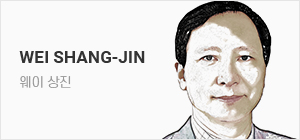이 기사는 해외 석학 기고글 플랫폼 '헤럴드 인사이트 컬렉션'에 게재된 기사입니다.
 |
| 중국 경제에 심상치 않은 기운이 가시지 않는 가운데 지난 5일 항저우의 증권거래소를 찾은 한 시민이 주식 시황에 주목하고 있다. |

The years of China‘s high growth are past, as the world painfully learned in 2023. Notwithstanding the enormous tailwinds stemming from having exited Zero-Covid policies during 2022, the Chinese economy barely made to reach the underwhelming 5% GDP growth target cautiously set by Premier Li Qiang back in March 2022.
The reasons for the very slow recovery of the Chinese economy in 2023 are both cyclical and structural. On the cyclical front, China‘s financial conditions have remained very tight in 2023 with very high real interest rates due to deflation. Such high real interest rates and the government crackdowns on a number of sectors have hurt those in need of funding, especially the private sector which remains more productive than state-owned enterprises. On the structural front, the main factor dragging down China’s growth is the plummeting return on investment. One of the key reasons for this is the slow and painful process of absorbing the real estate bubble accumulated during the past couple of decades. Low returns, however, have also reached infrastructure investment and even manufacturing. For the latter, Chinese authorities stubbornly pile up additional investment through different industrial policy plans to move up the ladder. The result, given the stagnant domestic investment and a more reluctant external demand, is increasing overcapacity with an immediate and important negative consequence for China persistent deflationary pressure. China‘s overcapacity is a double-edge sword for the world. For countries competing on the industrial space with China, such as South Korea or Germany, China’s overcapacity and deflationary pressures translate into formidable competition in third markets. On the positive side, China‘s deflation has also helped central banks globally in their fight against inflation, given China’s 20% share in global manufacturing exports.
All in all, both cyclical and structural headwinds are behind the very poor confidence in the Chinese economy both domestically as well as by foreign investors, which is well reflected in the extremely low stock market valuations. In fact, China‘s stock market is practically back to the levels of 2005 which is shockingly poor for an economy which has multiplied its GDP size nearly eight times since then. The question then is what to expect for 2024 and the most optimistic answer I can offer is a “muddling-through” of the Chinese economy, with growth decelerating only slightly compared to 2023, which means remaining in the 4.5-5% range. This goal, which in the past would have been underwhelming, will not be reached without support but even that is no longer easy. Monetary policy would need to be laxer to bring down the very high real interest rates that are hurting companies’ and households‘ access to credit. This is easier said than done as the People’s Bank of China (PBoC) also needs to stem off capital outflows and a further depreciation of the RMB. The Federal Reserve‘s hawkish stance clearly does not help as it leaves the PBoC with very little room to cut interest rates given the already very wide negative interest rate differential between China and the US, pushing even more capital out. The RMB lost nearly 9% in 2023 until the Fed changed its message towards easing in the third quarter of 2023 leading to the easing of the US dollar and, thus supporting the RMB. This support has only been temporary as the FED’s recent hesitation to cut rates too early in 2024, is supporting the US dollar and re-igniting capital outflows from China as well as a deepening stock market rout to which the PBoC quite mildly. In fact, no interest rate cut has been announced yet but also a further easing of liquidity with a a 50 basis point cut in reserve requirements, to which the market has responded with an even bigger sell-off.
Given the PBoC‘s conflicting objectives, (growth versus financial stability), it seems natural to turn to fiscal given the crucial role it played in stimulating the Chinese economy in the past, especially in 2008 after the global financial crisis but also in early 2016 after the stock market collapse in the second half of 2015. The reality is that China no longer has fiscal space as public debt is 4 times larger than in 2008 (100% of GDP compared to 25% then). This huge increase has mostly been generated by local governments’ wild infrastructure and real estate investment but also massive industrial policy to create manufacturing champions. Before the real estate cycle burst in mid 2021, local governments could still count on land sales to finance their expenditure, which also increased substantially during the Covid pandemic, especially for testing and quarantine. As if this were not enough, the growing interest rate burden of such a ballooning debt further limits local governments‘ space to support the economy. In other words, China’s local governments are starting to grapple with the problem of fiscal sustainability as growth decelerates and real interest rates reach record high levels, pushed up by deflation. As a consequence, it seems difficult to imagine that local governments will be able to stimulate the economy as was the case in the past without a fiscal reform which allows them to generate new sources of fiscal revenue. The hope that the central government is considering this major reform is vanishing as no direction has yet been offered by Premier Li Qiang or the new economic leadership since they took over nearly a year ago.
Against such backdrop, reviewing our expectations on the Chinese economy is more important than ever, with “muddling-through” being now placed as the most positive outcome to be expected. For this new normal of structural ― but slow ― deceleration to be achieved, major risks need to be averted. A very obvious one stems from the poor financial health of local governments. This risk has become more likely given that banks have been asked to support real estate developers, leaving very little room for them to continue to lend to local governments, some of which are finding it increasingly costly to place their debt.
Another key risk comes from China‘s obsession to continue to invest in manufacturing upgrade without the country’s own consumption able to absorb it. The never ending need for foreign demand to absorb China‘s manufacturing, giving growing overcapacity, in creating entrenched deflationary pleasures for China but also massive competition for other industrial nations, leading to protectionism.
Beyond economics, the widely expected geopolitical risk in 2024 was surely the Taiwan elections on January 13. While the Democratic and Progressive Party (DDP) clinched to the Presidency for the third time in a row, very much against Beijing‘s preferences, it lost the control of Taiwan’s legislative body (“the yuan”) in favour of China-most friendly party, the long-ruling Kuomintang (KMT). This is possibly the best news, in terms of easing China-related risks, that we may have for the rest of 2024, and the DPP will be very much constrained as regards its relations with the mainland and the mainland will also be keen to wait how the DPP‘s complicated presidency will evolve. The wild card, of course, will come in November with the US elections. All in all, it seems hard to argue that geopolitical risks are being contained but only transformed. China’s structural deceleration in creating cracks in the economy which could push the leadership to play harder with nationalist card.
In sum, we should be grateful if the Chinese economy is able to offer a boring 2024, with muddling through, since risks are only growing except for a nice New Year gift from Taiwan‘s elections which has lowered biggest geopolitical risk, at least temporarily.

올해 中경제 ‘힘겹게 헤쳐 나가는 시기’ 될 것
2023년 세계는 중국의 고성장 시대가 끝났다는 사실을 뼈저리게 배웠다. 2022년 제로코로나 정책 완화로 불어온 커다란 순풍에도, 중국 경제는 2022년 3월 리창 총리가 신중하게 설정했던 그저 그런 수준의 국내총생산(GDP) 성장 목표치 5%조차도 간신히 달성했다.
2023년 중국의 경제 회복이 매우 느렸던 데에는 경기순환적 이유와 구조적 이유가 공존한다. 경기순환적 측면에서 보면, 2023년 중국은 디플레이션으로 인해 실질 금리가 매우 높아지며 금융시장이 무척 경색돼 있었다. 높은 실질 금리와 여러 부문에 대한 정부의 단속은 자금을 필요로 하는 이들, 특히 국영 기업보다 생산성이 더 높은 민간 부문에 큰 타격을 입혔다. 구조적인 측면에서 중국의 성장을 저해하는 주요 요인은 투자수익률의 급락이다. 급락의 주요 이유 중 하나는 지난 수십 년 동안 쌓여온 부동산 거품을 흡수하는 느리고 지난한 과정 때문이다.
그런데 인프라 투자와 심지어 제조업까지 투자수익률이 낮아졌다. 중국 당국은 제조업을 한 단계 더 발전시키고자 다양한 산업 정책 계획을 통해 고집스럽게 추가적인 투자를 끌어모으고 있다. 그 결과, 침체된 국내 투자와 부진한 외부 수요로 인해 과잉 생산이 증가하며 중국의 지속적인 디플레이션 압력에 즉각적이고도 심각한 악영향을 미치고 있다. 전세계에게 중국의 과잉생산은 양날의 검이다. 한국과 독일처럼 산업 분야에서 중국과 경쟁하는 국가에게 중국의 과잉생산과 디플레이션 압력은 제3 시장에서의 치열한 경쟁을 의미한다. 한편, 긍정적인 점은 글로벌 제조업 수출의 20%를 차지하는 중국이 겪고 있는 디플레이션이 전 세계적으로 중앙은행들이 인플레이션과 싸우는 데 도움이 됐다는 것이다.
전체적으로 볼 때, 중국 경제에 대한 국내 및 해외 투자자의 낮은 신뢰도 뒤에는 이러한 경기순환적, 구조적 역풍이 자리하고 있으며, 이는 극도로 낮은 중국 증시 가치평가에 잘 반영돼 있다. 사실상 중국의 주식 시장은 2005년 수준으로 회귀했는데, 2005년 이후 중국의 GDP 규모가 거의 8배 증가했다는 사실을 고려하면 충격적으로 부진한 수준이다. 그렇다면 이제 2024년에 대한 전망이 궁금해진다.

이에 대해 필자가 할 수 있는 가장 낙관적인 대답은 중국 경제가 2023년 대비 성장이 약간 둔화하며, 4.5~5% 범위에서 성장하는 ‘힘겹게 헤쳐나가는 시기’가 될 것이란 것이다. 과거에는 실망스러웠을 이 목표조차 지원 없이는 달성이 어려울 것으로 보이지만, 지원조차 받기 쉽지 않을 수 있다. 기업과 가계의 대출 접근을 어렵게 만드는 높은 실질 금리를 낮추기 위해서는 통화정책을 완화해야 한다. 그러나 중국 인민은행은 자금유출 및 위안화의 추가 평가절하도 막아야 하기 때문에 이것이 말처럼 쉽지 않다. 중국으로부터의 자금유출을 촉발하는 미중 금리차를 고려했을 때, 미국 연방준비제도(Fed)의 매파적인 입장은 인민은행에 금리 인하의 여지를 거의 주지 않기 때문에 전혀 도움이 되지 않는다. 연준이 2023년 3분기 양적완화에 대한 입장을 바꾸면서 달러의 약세가 위안화 강세로 이어지게 되기 전까지 위안화의 가치는 2023년 거의 9% 하락했다. 그러나 반등은 일시적이었다. 최근 연준이 2024년 조기 금리 인하를 주저하면서 달러가 다시 강해지며, 중국으로부터의 자금유출에 다시 불을 붙이고 중국 증시의 부신을 심화시키고 있다. 실제로 아직 어떠한 금리 인하도 발표되지 않았지만, 지급준비율을 0.5%포인트 인하해 추가로 유동성을 확대하겠다는 중국 정부의 발표에 증시는 더 큰 매도세로 반응했다.
성장 대 금융 안정성이라는 인민은행의 상충되는 목표를 봤을 때, 과거 특히 글로벌 금융 위기 이후였던 2008년과 2015년 하반기 주식 시장 붕괴 이후 2016년초에 재정정책이 중국 경제 부양에 중요한 역할을 했다는 점을 생각해보면 재정정책으로의 전환은 당연한 수순으로 보인다. 그러나 현재의 중국은 공공 부채가 2008년 대비 4배 증가해 (당시 GDP의 25%, 현재 100%) 더 이상 재정적 여력이 없다. 이렇게 공공 부채가 크게 증가한 주된 이유는 지방 정부의 무분별한 인프라 및 부동산 투자와 제조업 챔피언 기업을 육성하기 위한 대규모 산업 정책 때문이었다.
 |
| 중국 경제의 뇌관으로 분석되는 부동산 ‘위기의 핵’인 부동산 개발업체 헝다(恒大·에버그란데)에 대해 홍콩 고등법원이 지난달 29일 헝다를 청산해달라는 채권자 청원을 승인했다. 풀어야 할 숙제가 많은 중국 당국이 어떤 수습 카드를 내놓을지 세계 경제의 이목이 쏠린다. 중국 동부 장쑤성 난징시에 있는 헝다가 건설한 주거지역의 모습이다. |
2021년 중반 부동산 위기가 터지기 전까지 지방 정부는 토지 판매를 통해 지출 자금을 조달할 수 있었다. 그런데 코로나 팬데믹 동안 특히 검사 및 격리 비용으로 인해 지방 정부의 지출이 상당히 증가했고, 설상가상으로 커져가는 부채로 인해 점점 늘어가는 이자 부담은 지방 정부가 경제를 뒷받침할 수 있을 거란 여지를 더욱 제한한다. 다시 말하자면, 성장이 둔화되고 디플레이션으로 인해 실질 금리가 사상 최고치를 기록하면서 중국의 지방 정부들이 재정적 지속가능성이라는 문제에 직면했다는 것이다. 그 결과, 지방 정부에 새로운 재정 수입원을 창출해주는 재정개혁 없이는 과거에 그랬던 것처럼 지방 정부가 경기를 부양해주리라 기대하기는 어려워 보인다. 또한, 거의 1년 전 취임한 리창 총리나 신임 경제 지도부가 아직 아무런 방향성도 제시하지 않고 있기 때문에 중앙 정부가 이러한 대대적인 개혁을 고려하고 있을 것이란 희망마저 희미해지고 있다.
이런 상황에서 중국 경제에 대한 우리의 기대를 조정하는 것은 그 어느 때보다 중요하다. 현재로선 중국 경제가 ‘힘겹게 헤쳐나가는 것’이 기대할 수 있는 가장 긍정적인 결과로 보인다. 그러나 이 구조적이지만 느린 성장 둔화라는 뉴 노멀도 주요 리스크들을 피할 수 있어야 달성 가능할 것이다. 뻔한 리스크 중 하나는 지방 정부의 열악한 재정 건정성이다. 부동산 개발업체를 지원하라는 요청을 받은 은행들은 지방 정부에 계속해서 대출을 해 줄 여유가 거의 없고, 일부 지방 정부는 이미 대출을 받는 게 점점 더 비싸지고 있다는 사실을 느끼고 있는 상황에서 이 리스크는 점점 더 커지고 있다. 또 하나의 주요 리스크는 내수 소비가 이를 흡수할 수 없는 상황임에도 제조업 업그레이드를 위한 투자를 계속하려는 중국의 집착이다. 중국의 제조업을 흡수하기 위해서는 해외 수요가 끊임없이 필요하고, 이는 과잉생산과 디플레이션 압력을 창출할 뿐 아니라 다른 산업 국가들과 대규모 경쟁을 야기함으로써 보호무역주의를 초래한다.
경제적인 곳 외에 널리 예상되는 2024년의 지정학적 리스크로는 1월 13일 대만 선거가 있었다. 중국이 원하던 바와는 다르게 민주진보당이 세 번 연속 총통직을 차지하게 됐지만, 입법부에 대한 통제력은 중국에 가장 우호적인 정당이자 제1당인 국민당의 손에 들어갔다. 이것은 중국 관련 리스크 완화 차원에서 아마도 남은 2024년 동안 들을 수 있는 가장 좋은 소식일 것이다. 민진당은 본토와의 관계 면에서 많은 제약을 받을 것이고, 본토는 민진당이 복잡다난한 총통직을 어떻게 수행해나갈지 예의 주시할 것이다. 물론 와일드카드는 미국 대선이 있는 11월에 등장할 것이다. 전체적으로 보면, 지정학적 리스크는 억제되고 있는 게 아니라 단순히 양상이 변화하고 있다고 할 수 있다. 중국의 구조적 성장 둔화는 경제에 균열을 일으키고 있고, 이로 인해 중국 지도부는 민족주의 카드를 더 강하게 사용하게 될 수도 있다.
요약하자면, 중국 경제가 어렵지만 그럭저럭 헤쳐가며 별일 없이 지루한 2024년을 보내기만 해도 우리는 감사해야 할 것이다. 가장 큰 지정학적 리스크를 잠시 낮춰준 대만 선거 결과라는 새해 선물을 제외하면 중국을 둘러싼 리스크는 계속 커지고 있기 때문이다.
알리시아 가르시아 에레로 벨기에 브뤼겔 연구소 선임 연구원
알리시아 가르시아 에레로 프로필
▷미국 조지워싱턴대 경제학 박사
▷스페인 BBVA 신흥시장 수석 이코노미스트
▷유럽중앙은행 집행이사회 고문
▷국제통화기금(IMF) 이코노미스트
▷프랑스 투자은행 나티시스(Natixis) 아시아태평양 지역 수석 이코노미스트















